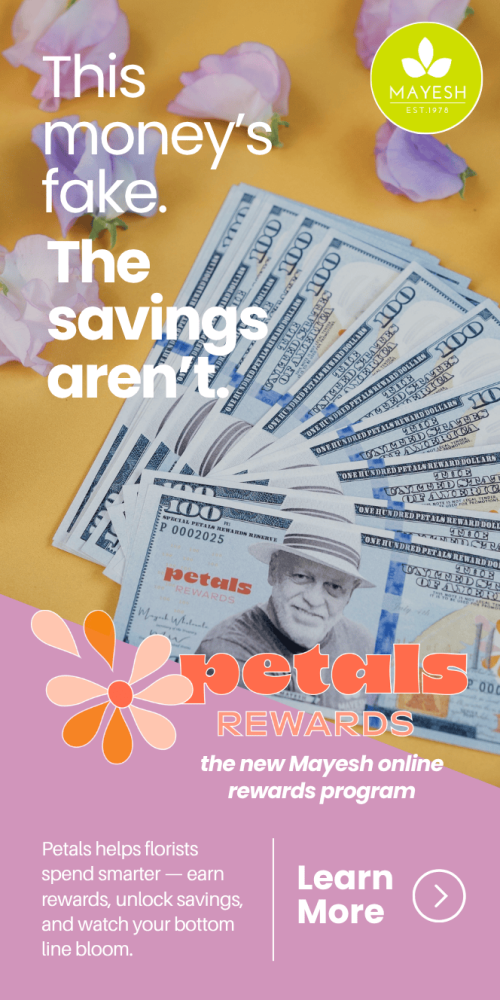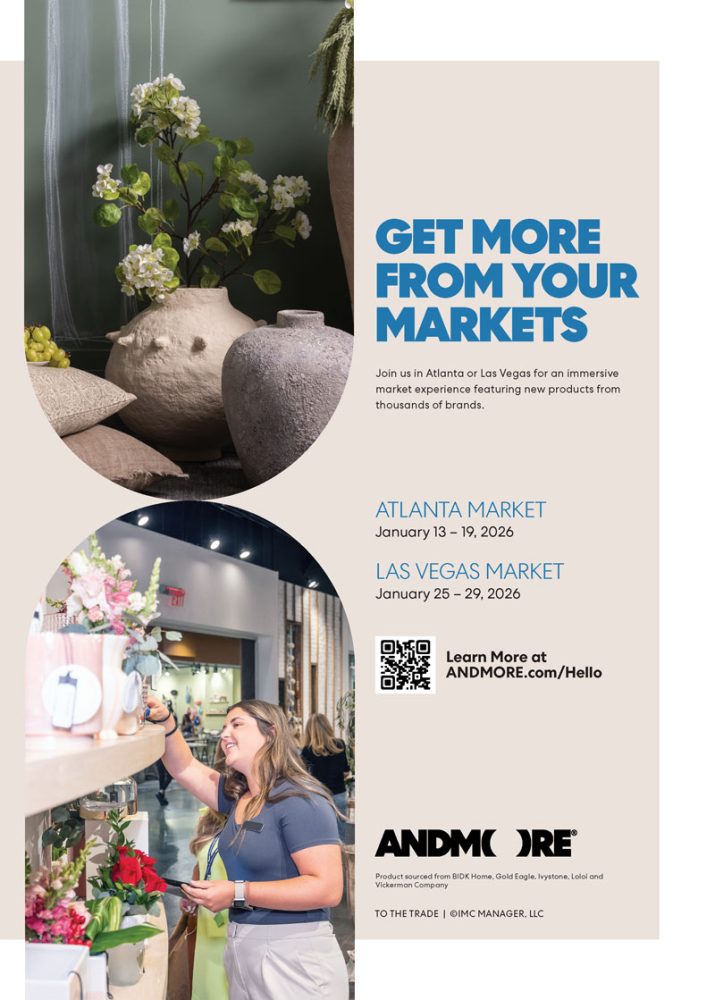Today’s ultra-realistic permanent botanicals are taking the world by storm, most notably trendy, high-end restaurants, hotels and fashion brands—and increasing numbers of flower businesses are working with faux flowers, foliages and plants almost exclusively
By Jill Brooke
When Floratorium’s Carlos Franqui started out as a florist after a career in fashion and advertising, he noticed fellow florists focusing on indoor arrangements, weddings and bouquets. “I wanted to differentiate myself,” he recalls. What could he do different, he asked himself. “Then it hit me. Instead of focusing on the inside of a shop, I realized the outside of buildings needed flowers too.”
But fresh flowers would be too expensive and perishable for his outdoors vision to be impactful. Too many were needed. Tulips weren’t plentiful in the dead of winter. Yes, faux flowers were available. “But in 2014, they had a bit of a stench around them” says Franqui, laughing at how most people dismissed them as décor for an old person’s facility.
But Franqui envisioned their kaleidoscope of virtues. Now, 10 years later, from his headquarters in Wood-Ridge, N.J., Franqui has created an empire around his faux flower installations. Just last December, he opened a Floratorium “La Botánica” outpost in the Little Haiti neighborhood of Miami, Fla. Indeed, the faux-flower movement is so popular that, in March of this year, The New York Times asked, “Why Are Restaurants Filling Up With Fake Flowers?” to another publication saying how “Fake Flower Décor New Trend.”
As the Times wrote, “Sprawling, towering, flamboyant installations of faux flowers and leaves are fast becoming a new hallmark of restaurant design, the florid successor to past fixations like open kitchens, Mason jars and those cordless lamps. In the last few years, they’ve sprung up across the United States and in cities like London, Paris, Toronto and Lagos, Nigeria. They form soaring arches, climb up dining room walls and send their tendrils deep into social media, where they brighten many a weekend-brunch post.”
Sabir Taheraly, managing partner of Jamali Garden in New York City, which started out in 1997 providing vases, gardening supplies and design-friendly event items to New York’s flower market, sees another reason for the faux flower popularity. Sure, Taheraly says, the pandemic increased public desire for flowers, creating 20 million new gardeners. But in that time frame, prices also increased for fresh flowers and impacted supply chains.
“Prices of fresh flowers have quadrupled, and some varieties aren’t easily available,” he points out. “It used to be that you could pay $10 for a bouquet that is now $25. Our collection [of faux flowers] mimics the real flower look, making them an ideal solution.”



Pop culture also helped. Shows like Netflix’s Bridgerton had people craving floating Wisteria blooms hanging from vines— which remains a popular seller, along with Bougainvillea.
Now a florist missing a flower from a bad shipment? No problem. The Hydrangea blooms are dropping? Substitute faux Hydrangea among the flock of other flowers.
“You have such variety of colors nowadays,” adds Brenda LaManna, founder and president of Damselfly Florals & Events, which has locations throughout New York City as well as in White Plains, N.Y., and Wilton, Conn. LaManna is known for eschewing plastic for biodegradable packaging.
It’s not an oxymoron to appreciate faux, which lasts forever, and focus more on waste from packaging. For me personally, I am such a faux flower fan that I will sprinkle faux Zinnia and peonies in my boxwoods during the winter months for a pop of outside color to lift my spirits. I decorate planters of hyacinths with faux petite Forsythia to fill it out. The English actor John Barrie once said, “God gave us memory so that we might have roses in December.” But now flowers don’t have to be only a memory, regardless of season.
Furthermore, the faux-flower trend has dovetailed at a time when the manufacturing possibilities offer a better product. “It is now often hard to tell the difference between the real and the artificial,” says Mary Ragon, founder of Ragon House, a distributor of high-quality permanent botanicals, home décor and furnishings, decorative accessories and more based in Bolivar, Ohio. “So many of the current artificial florals are crafted by hand with a great attention to detail, life-like textures and realistic colors.”

Patricia Gonzalez, project developer at Floratorium, says the company has installed faux flowers in more than 300 restaurants in the U.S. and Canada, along with “hotels, businesses and luxury residences.” Some of the big name clients include famed restaurants such as Marea, Avra Estiatoria and the Tao Group Hospitality’s LAVO Italian Restaurants; fashion brands Versace, Sézane and Intimissimi; Moxy Hotels; and Diptyque, among scores of others.
Real-estate agents also welcome florists who are adept with faux and real flowers. “During showings, especially for luxury properties, having a mix of low maintenance real and high-quality faux branches and blossoms brightens up a space and keeps it show-ready for weeks” says Diana Rice, a star agent at Sotheby’s International Realty in Manhattan. “I wouldn’t think of photographing without them because they are essential.”
Franqui is by no means the only one recognizing the bounty from these performing botanicals. All across the country, florists are finding revenue streams—and fans—by utilizing faux flowers. According to the data analytics company Circana, sales of artificial plants and dried flowers reached $2.3 billion last year in the United States, a 52 percent increase from 2020.
In Fargo and Bismarck, N.D., Melissa Reichert, special events + culture lead at Love Always Floral, is finding success with faux florals, too. Store openings and corporate events now expect an Instagram-friendly floral display, she says. “We were hesitant at first, and our hearts were always with using live flowers,” she shares. “But a lot of retail and corporate companies are looking for special experiences for their customers. Live installations die in a week or a day. Not so with faux florals.”
Reichert notes that when she sees “the smiles and joy [they] bring customers and to the corporate clients,” she is no longer resistant. “It’s now grown into being part of our business. It’s having a lasting impact on how the public is also appreciating flowers.”

So popular is the faux-flower trend that people now look forward to a local pop-up or new restaurant décor. “People now expect a new floral design like they expect new items on a menu each season,” notes Rosanna Scotto, who hires Lawrence Scott, owner of Lawrence Scott Events in Hicksville, N.Y., to create floral frescoes at her family’s Italian restaurant in New York City, Fresco by Scotto. For the restaurant’s spring and summer installation, Scott included pots of Hydrangea along with the faux flourishes.
These installments are not inexpensive. The average installation can cost $40,000 from these floral stars. Other installations average north of $10,000 around the country. Typical flower budgets in the past for high-end restaurants may have been $5,000 monthly in top cities.
“We have proven to business owners and hoteliers that they can see ROI on doing this with little maintenance,” says Floratorium’s Gonzalez. “With fresh flowers, you are changing them weekly. We not only alleviate overall flower budgets but reduce worries about people coming to the establishment to change the flowers.” (And that is no picnic for florists either because most hotels require them to come at 5 a.m. and earlier, before guests are up). “The quality now is so good that it’s become a game changer.”

In fact, says Mary Ragon, more good things are to come. “The latest trend is creating flowers that ‘feel real,’” she says. “Customers absolutely love this type of product. Not only do they look astonishingly real but now they also feel real. Who could ask for more?”
























